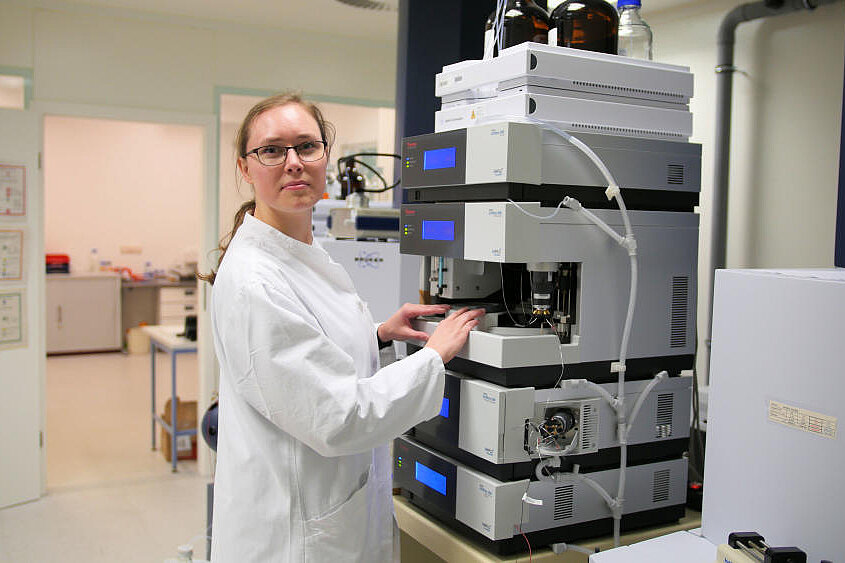The PK/PD unit is currently testing a substance that could be effective against the new coronavirus SARS (severe acute respiratory syndrome)-CoV-2. The spread of the highly infectious respiratory disease COVID-19 caused by the virus has developed into a pandemic. Research into active substances against SARS-CoV-2 is being conducted at full speed.
“The call came in early February,” says Dr Katharina Rox from the department “Chemical Biology” at the Helmholtz Centre for Infection Research (HZI) in Braunschweig. “Could we open up testing resources for a promising drug candidate against SARS-CoV-2 at short notice? We could – a week later, we started our preclinical testing series.” The 31-year-old pharmacist established the PK/PD unit in 2015 on the initiative of the German Center for Infection Research (DZIF). The unit subjects potential drug candidates against bacterial or viral pathogens to rigorous testing using special early test procedures. Crucial questions for pharmacokinetics – How is the agent distributed in the body? How stable is it? – and pharmacodynamics – How effective is it? What dose is required? – are answered in this process. “We assist research groups with detailed testing of their drug candidates in the early preclinical phase, and optimise the candidates so that they have the best prerequisites for success in further development towards clinical trials,” says Rox.
The PK/PD unit within the Novel Antibiotics research area at the DZIF, coordinated by Prof Rolf Müller (HZI branch Helmholtz Institute for Pharmaceutical Research Saarland, HIPS), is affiliated with the Chemical Biology (Prof Mark Brönstrup) and Infection Immunology (Prof Eva Medina) departments at the HZI. It works in close collaboration with partners from the DZIF and other research institutes and universities. Furthermore, it is also internationally networked, for example with the SCORE (Swift Coronavirus Therapeutics Response) consortium, an association of European research groups that are working on the rapid development of therapeutics against SARS-CoV-2. Testing active substances that are effective against coronaviruses is nothing new for Rox and her team. “We have been working with Prof Rolf Hilgenfeld’s team from the Institute of Biochemistry at the University of Lübeck for around two years now, testing substances that are expected to be effective against different types of coronaviruses,” says Rox. “The previous SARS and MERS epidemics have shown that coronaviruses can be quite problematic. The aim was to have a broad-spectrum anti-corona agent available in the event of an outbreak of a new and dangerous coronavirus. But unfortunately, SARS-CoV-2 was faster.”
The telephone call at the start of February came from Rolf Hilgenfeld. In January, his team, working together with partners in China, developed a drug candidate called “13b”in just a few days, as the COVID-19 epidemic was spreading in Wuhan (China). Katharina Rox was going to take a closer look at this candidate in her preclinical testing procedures. “Our comprehensive tests help us to determine the initial key parameters that are most important for safety and efficacy in the organism,” says Rox. “To do this, the drug candidate undergoes a three-stage testing process.” First, various in vitro tests are performed, to learn as much as possible about the properties and behaviour of the active ingredient in the body: Does the substance have toxic properties? How does it behave in blood plasma? Does it withstand the different pH values of the gastrointestinal tract? How quickly is it metabolised? This is followed by a range of in vivo investigations in healthy mice. “Here we aim to find out how the active substance is distributed in the organism. Whether it actually arrives where it is needed – such as in a particular tissue or organ – and how it is best applied to achieve this, as well as the necessary dose to reach a certain level of the active ingredient,” explains Rox. Only when the results of the first two testing stages are satisfactory is the active ingredient then subjected to efficacy tests on mice infected with the relevant pathogen and the optimum dosage determined. “In addition to lab tests, we are also increasingly working with computer models to be able to make better predictions and to keep animal testing to a minimum,” says Rox.
What did the PK/PD unit discover in their testing series on the substance 13b? “Our preclinical tests are not yet complete, but the results so far are very promising,” says Rox. “The substance is stable in plasma and is not broken down too quickly by metabolic processes. We were able to achieve long-lasting concentrations of the active ingredient in the mice using inhalation or injection of the active ingredient under the skin. 13b also accumulates well in the lungs – the main place where it should be available, as the virus causes severe inflammation there.” The results from the PK/PD unit are part of a joint study by the University of Lübeck, the HZI, the DZIF and other partners that was recently published in the journal Science.


